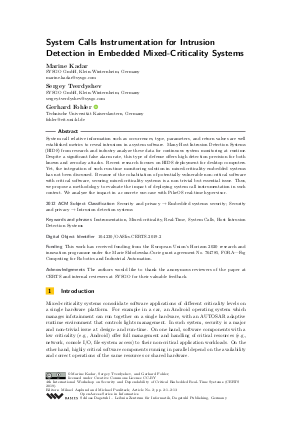OASIcs.CERTS.2019.2.pdf
- Filesize: 436 kB
- 13 pages

 Creative Commons Attribution 3.0 Unported license
Creative Commons Attribution 3.0 Unported license

System call relative information such as occurrences, type, parameters, and return values are well established metrics to reveal intrusions in a system software. Many Host Intrusion Detection Systems (HIDS) from research and industry analyze these data for continuous system monitoring at runtime. Despite a significant false alarm rate, this type of defense offers high detection precision for both known and zero-day attacks. Recent research focuses on HIDS deployment for desktop computers. Yet, the integration of such run-time monitoring solution in mixed-criticality embedded systems has not been discussed. Because of the cohabitation of potentially vulnerable non-critical software with critical software, securing mixed-criticality systems is a non trivial but essential issue. Thus, we propose a methodology to evaluate the impact of deploying system call instrumentation in such context. We analyze the impact in a concrete use-case with PikeOS real-time hypervisor.














Feedback for Dagstuhl Publishing